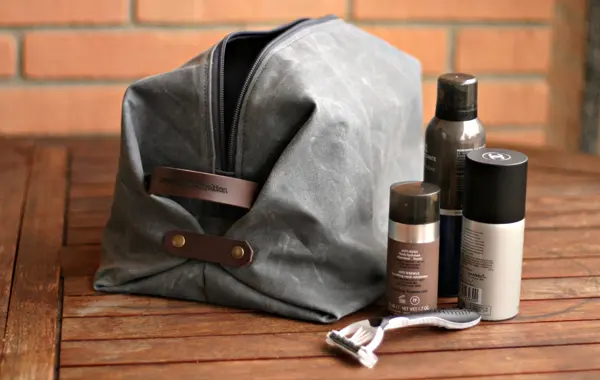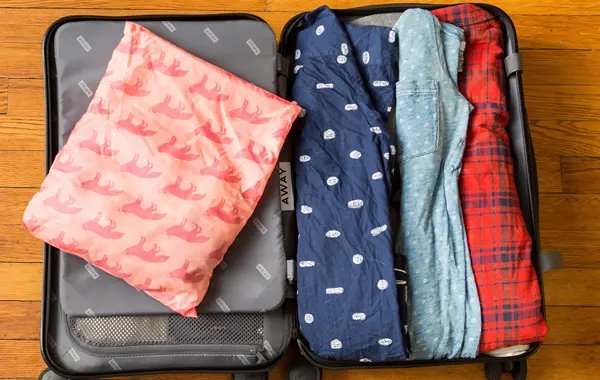Business trips are often more important than your regular day to day, but they leave you outside of your comfort zone and stuck with limited resources. Combined with how frequently they come up on short notice, it’s easy to see why proper packing can save you a lot of hassle down the road.
You want to put your best foot forward, which means having the resources and supplies necessary to look and feel your best. You don’t want to leave your dress socks at home, end up with a wrinkled suit, or feel disheveled from a lack of comfortable sleep.
Proper preparation prevents piss poor performance. Proper packing prepares people for perfect presentation. Pack properly and your trips will go so smoothly you’ll look forward to them rather than dread them.
1: Plan Ahead in Detail
Before you even begin to pack, snag a copy of Evernote for your favorite devices and start planning ahead. Figure out what the weather is going to be like in your location during the trip, what sort of seasonal necessities – allergy medicine, sunblock, lotion for dry skin – that you might need, and figure out what can be reliably obtained or provided for you at your destination. The less you need to bring with you, the more space you have and the fewer possessions you have to keep track of along the way. Read up on the airline you’re taking and learn their limitations on carry-on baggage. This will be important later.

Start making a list of items you want to pack and bring with you, down to the last sock. Note down the number of clothing items, jewelry items, toiletries, and other necessities. Don’t remove items from the list when you pack them; this checklist can be used before you leave for home to make sure you’re not missing anything in a hotel room. If you’re traveling internationally, read up on the customs and etiquette of the country you’re visiting.
Once you have most of your list complete, start gathering your items all in one place. You’ll think of more along the way; add them to the list or carefully consider whether or not you’ll need them. Don’t forget accessories like extra styli, charging cables, USB connectors, and batteries.
With everything in one place, audit your baggage and determine if you’re going to be able to cram everything into carry-on luggage or not. Checking bags isn’t a bad thing, necessarily, but it does open you up to more risk. If you’re used to traveling light, you might blank on even retrieving your checked bags. It’s an extra case to haul around, it’s less convenient, and it opens you up to the risk of a bag getting lost along the way.
You can also consider packing bags within bags. One of the recent trends is in “travel cubes”, which allow you to segment your packing in a flexible but easily-rearranged way. You’ll have to check them out to see if they’re right for you. If you’re a frequent traveler, you can pack in a modular way to keep everything carefully organized.
2: Prepare a Pre-Packed Bag
A small carry-on or module for inside your primary luggage can take a lot of the hassle out of repeated packing. It’s a great idea for frequent travelers or anyone anticipating traveling several times in a given few months.
The idea is to create a bag that can fit inside your other bags, that is packed with travel-exclusive necessities. Don’t pack away things you need in your day to day life; this bag is solely for items you won’t remove from the bag except while traveling. Items like travel-sized toiletries, spare socks and underwear, and backup cash all go in this bag. Likewise, including backup chargers, universal plug adapters, and extra storage is a good idea.

What you stash in this bag depends on your personal travel style and the items you consider necessities. Make sure you keep it up to date, though. If you get a new device that doesn’t work with old chargers or cables, put new cables in the backup bag. If you’re running low on a particular toiletry necessity, add more. Avoid putting in anything that will spoil or break through long term storage or temperature and humidity changes. Nothing is worse than opening up your backup back to find a bottle of mouthwash exploded months ago and soaked everything, or a battery corroded and ruined a necessary cable.
3: Put Digital Necessities on the Cloud
The days of having to haul around a heavy laptop, an external hard drive, a handful of CDs and other forms of media storage are over. These days you can accomplish everything with a tablet and, maybe, an Internet-enabled Chromebook or other lightweight laptop device. Even if you need to get a loaner item from your company IT department, it’s fine; you can store all of your data on the cloud and access it from any device later on. Just make sure you set up and test the device in question to make sure everything works before you leave. Leave nothing to chance.
When you’re storing data, particularly important company data, on the cloud, you need to make sure it’s secure. There are a lot of features you need out of business-tier cloud storage. You need reliable tech support, plenty of storage space, high quality encryption, sync, collaboration tools, and more.

You can potentially do the same thing with any paper documentation you need while you’re on location. Rather than packing up a folio, create digital versions of the paperwork you need and have them printed when you’re on site. Alternatively, make up a package of necessities and mail it ahead of time, to be delivered to your hotel and held for you when you arrive. I recommend having digital backups anyway, just in case your physical versions encounter a messy rainstorm or are lost in transit. Just make sure you’re able to access a print center with reasonable prices at your destination.
4: Pick a Space-Efficient Packing Technique
When you’re actually packing your bags, you have to choose whether you want to go with the roll style or the flat style. Flat is more traditional, but needs some more preparation to avoid certain negative outcomes, like a crease in a starched collar.
The flat packing method begins by layering in small necessities like underwear along the bottom of your suitcase to create a level, flat surface.

Once that is done, layer in longer flat items like pants and dresses. Top that with shirts. Align everything to one edge of the suitcase, and don’t worry if items drape outside of the bottom. Pack shoes in shoe bags and tuck curved or stiff items in out of the way corners. Finally, fold the draped edges inwards.
The rolling method starts with shoes and other small items, rolled individually, and packed to fill in gaps around a level surface.

Each item should be rolled tightly and packed in a sensible way, both to maximize space utilization and to make it accessible when you need it. Make sure to have bags to store wet or dirty items, like shoes or bathing suits. Anything that can’t be rolled should be saved to drape over last.
5: Bring Backup Necessities
This tip goes hand in hand with having your pre-packed bag. The goal is to have a stash of necessities, the items that you absolutely need every time you travel, because you use them in your daily life. Anything you need but could potentially forget, like charging cables, headphones, computer accessories and the like, should be on top of your list.
One thing you should strongly consider if you travel frequently is to buy a second copy of certain necessities you keep every trip. A particular set of headphones, for example, make a good secondary purchase. You can also buy backups of cables for your electronics.

This isn’t limited to technology, either. I like to have an extra stash of underwear, socks, and other clothing necessities packed away. I have a spare pair of nice shoes I wore just enough to break them in before packing away and leaving for trips. Extra belts and other pieces of accessory clothing can be just as important, and you don’t want to have to go out and buy one at the last minute on site.
It’s up to you what you consider essential enough to have a secondary copy of for your travel bag. If you travel light, you might not have much. If you pack a wardrobe every time, you might have a large checked bag of necessities. If you don’t travel often, you might not even need such a bag.
6: Avoid the Travel Gimmicks
Selling strange items to business travelers is a billion-dollar industry. There are so many ridiculous items and strange ideas out there. Honestly, most of them are more hassle than they’re worth.
Take all of the strange travel pillows, for example. Who needs an ostrich pillow, one of those big bulky things that pulls over your head so you can sleep anywhere? Or how about that thing that looks like a stretched out sweater, designed to shove your head, arms, and laptop all into the same stuffy hole? No one needs these, they look ridiculous, and worse, they’re bulky and inconvenient to carry around.
You also have the travel services popping up now, like the two or three competing services that ship clothing to you at your destination and allow you to leave the items behind for collection later. I don’t know about you, but I’d rather have clothing I’m comfortable in than clothing given to me by a service that put it through who knows what before they gave it to me. These are especially bad if you have allergies to certain detergents; you have no control over what’s embedded in the fabric.
Almost always, the gimmicks marketed at travelers in general are going to be terrible. They’re either unitaskers that take up a lot of space and are a pain to carry around, or they’re too expensive to do what you can accomplish with much smaller items. People have been successfully and comfortably traveling around the globe for decades before many of these items came out; you don’t need to fall for their trap. No one is going to judge you for using Ziplocs instead of special travel bags.
7. The Return Trip
Remember how I said not to remove anything from your checklist as you’re packing? This is why. When you’re in your hotel, packing up for your return trip, the last thing you want to do is forget something essential. Pull out your list and start checking items off once you pack them up, just like you did before.
As an added bonus, you can also make a mark next to items you wanted more of, items you had to buy because you forgot, and items you didn’t use. This way, next time you travel, you can refine your list. Was an item unnecessary, but potentially useful, like rain gear? That’s fine. How about an item you thought you would need but never did? Nuke it. Items you consumed and needed more of can be included in greater quantity next time. Items you forgot and had to obtain can be added to the list – or to your pre-packed necessities bag – so you don’t forget them again.
The more foundational organization you do on the fly, the less you have to do in the crunch time leading up to your next business trip. Save yourself the time, the energy, and the stress, by keeping notes and packing a semi-permanent bag. If you travel frequently, your future self will thank you every trip.






















0 Comments